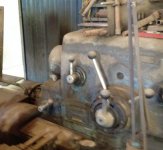SLG
Cast Iron
- Joined
- Jun 4, 2014
- Location
- New Mexico
I'm not a lathe guy, but I need one to make some small and relatively sloppy prototype parts. I want to try and purchase a machine that has future potential, and not some chi-com crap. I'd like to keep my expenditure to $1800 or less.
Before I go to the expense of visiting this old dsg, I wanted to post what pictures I have and see if any of you can see any glaring deficiencies in it - missing parts, shafts, leads, etc. This is a 21, no serial number available, not much info besides what you see. I believe this is a "newer" model, as I do not see a motor hanging off the end.
It appears as though a lever is missing from the headstock, but from other photos/videos I've seen, this is normal for the 21.
It is not currently under power, but I will be able to put power to it when I inspect it. Unless I purchase a straight edge, the way condition will be a guess.
Thanks for the help
Before I go to the expense of visiting this old dsg, I wanted to post what pictures I have and see if any of you can see any glaring deficiencies in it - missing parts, shafts, leads, etc. This is a 21, no serial number available, not much info besides what you see. I believe this is a "newer" model, as I do not see a motor hanging off the end.
It appears as though a lever is missing from the headstock, but from other photos/videos I've seen, this is normal for the 21.
It is not currently under power, but I will be able to put power to it when I inspect it. Unless I purchase a straight edge, the way condition will be a guess.
Thanks for the help






